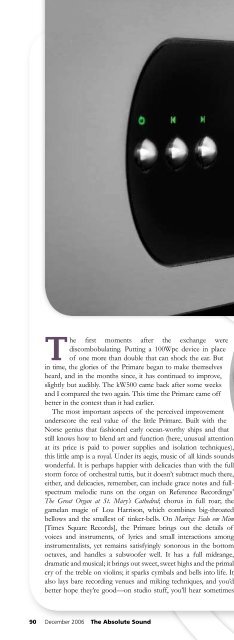Create successful ePaper yourself
Turn your PDF publications into a flip-book with our unique Google optimized e-Paper software.
The first moments after the exchange were<br />
discombobulating. Putting a 100Wpc device in place<br />
of one more than double that can shock the ear. But<br />
in time, the glories of the Primare began to make themselves<br />
heard, and in the months since, it has continued to improve,<br />
slightly but audibly. The kW500 came back after some weeks<br />
and I compared the two again. This time the Primare came off<br />
better in the contest than it had earlier.<br />
The most important aspects of the perceived improvement<br />
underscore the real value of the little Primare. Built with the<br />
Norse genius that fashioned early ocean-worthy ships and that<br />
still knows how to blend art and function (here, unusual attention<br />
at its price is paid to power supplies and isolation techniques),<br />
this little amp is a royal. Under its aegis, music of all kinds sounds<br />
wonderful. It is perhaps happier with delicacies than with the full<br />
storm force of orchestral tuttis, but it doesn’t subtract much there,<br />
either, and delicacies, remember, can include grace notes and fullspectrum<br />
melodic runs on the organ on Reference Recordings’<br />
The Great Organ at St. Mary’s Cathedral; chorus in full roar; the<br />
gamelan magic of Lou Harrison, which combines big-throated<br />
bellows and the smallest of tinker-bells. On Mariza: Fado em Mim<br />
[Times Square Records], the Primare brings out the details of<br />
voices and instruments, of lyrics and small interactions among<br />
instrumentalists, yet remains satisfyingly sonorous in the bottom<br />
octaves, and handles a subwoofer well. It has a full midrange,<br />
dramatic and musical; it brings out sweet, sweet highs and the primal<br />
cry of the treble on violins; it sparks cymbals and bells into life. It<br />
also lays bare recording venues and miking techniques, and you’d<br />
better hope they’re good—on studio stuff, you’ll hear sometimes<br />
more than you want to. For instance, in Woman of Song [Chesky],<br />
Rebecca Pigeon’s lovely, controlled soprano soared out of an overly<br />
reverberant studio that nearly marred the songs. I hadn’t heard that<br />
studio hollowness so clearly before.<br />
More powerful amps of equally good provenance have greater<br />
height in the stage, deeper lows, and the veritable power-pulse of<br />
large music that less powerful units lack. But the Primare has so<br />
little distortion and so few “noise” effects, it shines.<br />
After first pairing the 130 with the Musical Fidelity A5 CD player,<br />
I put in the Primare CD31 ($2295), which, initially, was startling. This<br />
little unit, like its integrated sister, has that remarkable combination<br />
90 December 2006 The Absolute Sound










